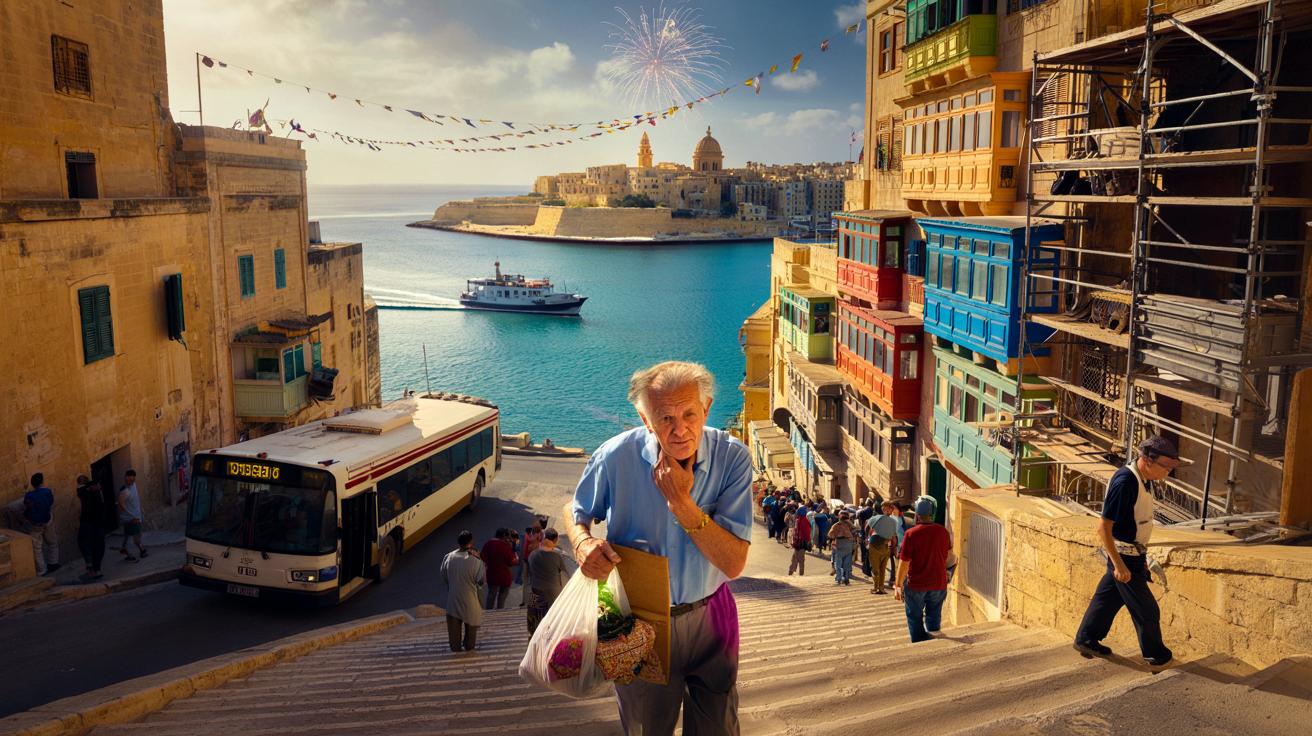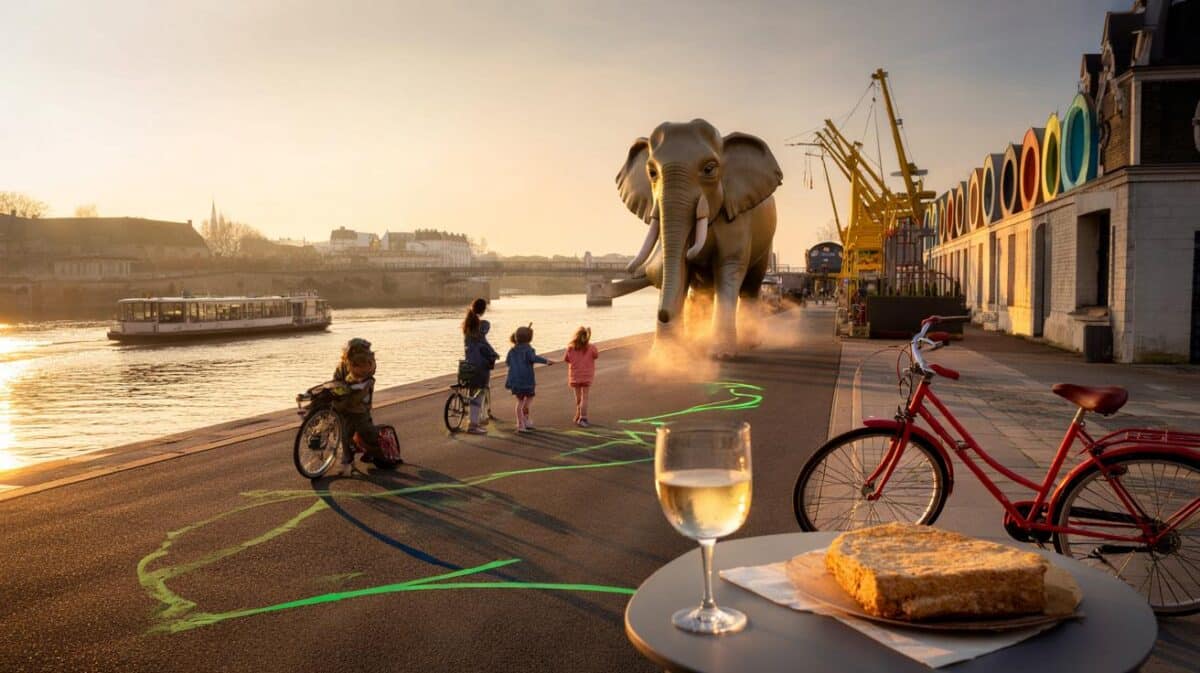A month on the island taught me a different lesson. The dream is lovely. The daily grind is loud.
The first morning felt like a film set. Sun bouncing off honeyed stone. Old men in flat caps comparing tomatoes at the market. I took the ferry from Sliema to Valletta and stood on deck, hair pinned by warm wind, thinking, yes — this is the life.
Then the week unfolded. Buses thudded past, already full by 7 a.m. A drill started up on the next block and ran till dusk. Groceries were oddly pricey for an island this small. The sea still glittered, faithful as ever. Yet somewhere between the fireworks at midnight and church bells at dawn, a question began to hum. Something didn’t add up.
I started to wonder what growing old here would really feel like.
The postcard and the small print
Malta dazzles you first. Turquoise water you can read your thoughts in. Golden facades that catch fire at sunset. Then the heat sits on your shoulders like a rucksack you can’t take off. I walked two hilly blocks at midday and felt wrung out. Shade is rare, pavements narrow, and the humidity wraps around your chest.
One Tuesday I tried to reach a GP in Paola from St Julian’s. Three buses passed, already standing-room-only. The ride that finally came took 65 minutes to crawl six miles. That night the festa fireworks shattered the sky at 11. Then the bells started at 5. Malta’s population density is among the highest in Europe, and you feel it in your ears.
Costs nudged me, too. Rents have surged in popular areas like Sliema and St Julian’s, and even modest flats want island-view money. Most groceries are imported, electricity can spike if you live with air-con on, and private healthcare jumps the queue but not the bill. **Retirement isn’t a permanent holiday; it’s an everyday life.** The sums started to look less Mediterranean and more metropolitan.
What I’d do differently before choosing a place to retire
Test-drive the island in the season that scares you. A week in August is worth ten brochures. Spend a day doing nothing heroic: pharmacy, small shop, bus to the doctor, walk to the seafront and back. **Heat isn’t just a number on a forecast; it’s a daily decision-maker.** If you come away knackered, listen to that.
Don’t rent the view first and the staircase later. Many flats are up two or three flights with no lift, and those limestone steps get slippery in winter damp. Buses work, but on busy routes you’ll wait while three sail past full. Winter can be bone-cold indoors, strange as that sounds, because stone walls hold moisture. We’ve all had that moment when the place we love on holiday starts to feel like work.
Speak to people who’ve done a full year, not just a spring fling. Ask them what broke, what surprised them, what cost more than expected. *The sea still got me, every single day.*
“If you love Malta in August, you’ll love it for life,” a Maltese neighbour told me, fanning herself with yesterday’s paper. “If not, try April and October. That’s our sweet spot.”
- Trial months: August for heat, January for damp, October for the rhythm.
- Compare areas: Sliema/St Julian’s for buzz, Valletta for beauty, Birgu for heritage, Gozo for slower days.
- Flat checklist: lift or low floor, cross‑ventilation, AC in bedrooms, double glazing, no construction next door.
- Transport reality: buses for patience, ferries for joy, a small car for groceries and medical runs.
- Budget buffer: add 15–20% to the rent and utilities you think you’ll pay.
Why the romance frayed for me
Noise wore me down first. Drilling, festas, engines idling on tight streets. Then the logistics: crowded buses, steep steps, short pavements, and a weekly shop that needed strategy. I loved the colour and kindness; I struggled with the friction. Let’s be honest: nobody does that every day. **Try Malta in August before you marry it in October.**
So, did Malta change or did I?
I don’t think Malta failed me. I think the island is honest in a way brochures aren’t. It’s vivid, social, layered with history, wildly photogenic — and also dense, loud, and physically demanding in summer. For a fortnight it’s intoxicating. For a month it asks what you really want from your later years.
Retirement likes gentler edges: slow mornings, easy errands, quiet nights, neighbours you actually hear over the fireworks. Gozo tempted me with that pace, and inland towns without party lungs felt calmer. There’s a version of life here that could work, just not the one I first imagined with a balcony over a main road and a bus pass as my best friend.
I left with a sun-creased face and a clearer head. The island is still there in my mind — water clapping the rocks, cats threading the alleys, church domes catching the last orange light. I still love it, only from arm’s length. Maybe that’s the most grown-up kind of love.
| Point clé | Détail | Intérêt pour le lecteur |
|---|---|---|
| Heat and density shape daily life | High humidity, steep walks, crowded transport, frequent noise | Sets real expectations for comfort and routines |
| Budget beyond the brochure | Rents in hotspots, imported groceries, AC-heavy bills | Helps plan a realistic retirement budget |
| Trial months matter | Visit in August and January, not just May | Reduces risk of expensive relocation regrets |
FAQ :
- Is healthcare good enough for retirees in Malta?Public care is respected, with modern hospitals and English widely spoken. Private clinics cut waiting times, at a price.
- How expensive is rent in popular areas?Sea‑adjacent neighbourhoods like Sliema, St Julian’s and Valletta command EU‑city prices. Go inland or to Gozo for value.
- Do I need a car?Buses cover the island, yet they’re crowded on key routes. A small car helps for shopping, medical appointments and off‑peak trips.
- What’s winter like inside stone apartments?Cool and damp. Without good heating and ventilation, it can feel colder indoors than outside.
- Which areas felt most liveable for a quieter retirement?Birgu and Senglea for heritage calm, parts of Naxxar or Attard for suburban ease, and Gozo for a slower rhythm.








